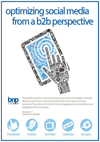Adobe, Burger King, and Skype: They’ve all had their social media accounts hacked, resulting in brief but highly publicized smear campaigns.
It’s a risk any business or person with a Twitter, Facebook or other social networking account faces. Hackers attack, passwords fall into the wrong hands, or the wrongdoing comes from someone within the organization. It all makes social media sound very risky for a brand trying to build and uphold its reputation.
But there’s a bigger risk in today’s business world – not engaging on social media. Forrester Research reports of staggering business opportunity through social channels, to the tune of $170 for every fan a brand has on Facebook. And with Twitter, the payoff could reach into the trillions.
There is, of course, a way to navigate these lucrative spaces securely. With the following practices in place, organizations can keep posting and tweeting, knowing these efforts will support business goals without undermining privacy and security.
1)Get serious about passwords. Believe it or not, people still use passwords like “password” or “123456.” Few people realize that complex passwords, combining upper- and lowercase letters, numbers and symbols, form the best line of defense against cyber attacks. Instead of choosing easy words or personal details, consider strategies like using the first letter of each word of a common phrase or song lyric. (“I can’t get no satisfaction” becomes ICGNS. Even better, IcGnS!.) Or, use an automatic password generator.
Also, rein in who has password access. Single sign-on technology offers the safest approach to password management. It’s available through business-grade Social Relationship Platforms (SRPs), and it enables employees to log into social media accounts with the same usernames and passwords they use for their company emails. The IT department holds the master switch for turning accounts on and off and therefore can easily revoke access to social media accounts from individual employees, should the need ever arise.
2) Centralize social media channels.Large companies are sometimes surprised to discover that their employees have started dozens of “corporate” social media accounts, often without official permission. A crucial first step in getting social media security under control is to consolidate all of these accounts within a single social media management system, which allows users to publish to multiple profiles on Twitter, Facebook, LinkedIn, and other networks from one secure interface.
This kind of system also acts like an extra firewall. One of the most common ways for hackers to gain access to passwords and sensitive data is through malicious links posted on social media sites and elsewhere. Clicking on what looks like a great deal, for instance, may land someone on a bogus site where malware is instantly downloaded to a company computer. The better social media management systems out there have built-in malware and spam prevention tools, which will automatically issue a warning before opening suspicious pages.
3) Control who can post messages.Social media accounts at consumer brands can have millions of followers. Entrusting the keys to these accounts to entry-level employees or interns carries significant risk. A better approach is to use an SRP that restricts who can publish messages. With some SRPs, companies can grant certain employees limited permission to draft messages. The messages go to an approval queue, and senior management must sign off on them before they go up on any sites. This process ensures that all social messaging meets company standards, and no illicit tweets or posts slip through.
4) Offer basic social media education.Just a few years ago, social media was a dorm room toy. Today, it’s a cornerstone of marketing and sales strategy at the planet’s biggest companies. Giving employees access to this kind of power without any basic education is tantamount to handing over keys to the car without a driver’s ed course. Structured training on security and compliance issues, as well as on more advanced themes like using social media to sell to clients and improve internal workflows, is critical. Fortunately, some of the best social media tools now come equipped with online courseware and webinars for their users.
There will always be some level of risk with social media. It’s public; it’s pervasive; it can be vulnerable. But the above precautions make social communication much less precarious and all the more valuable for brining in customers, securing their loyalty, recruiting the best talent and taking business to the next level. So go ahead, get out there and socialize. Just be smart about it.









